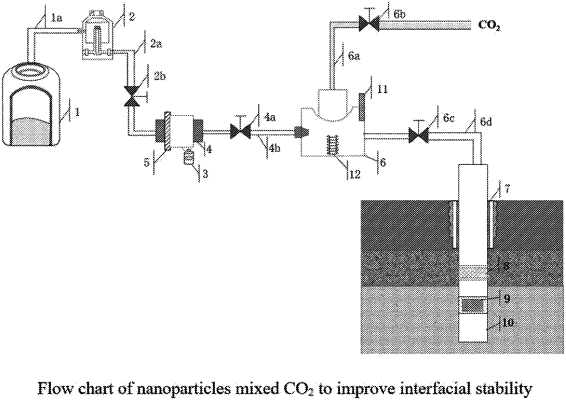| CPC C09K 8/594 (2013.01) [C09K 2208/10 (2013.01)] | 1 Claim |

|
1. A method for enhancing geological storage by injecting nanoparticles to stabilize CO2 microbubbles,
comprising:
step I: determining a location of an injection well:
selecting a storage position to install the injection well, and installing a monitoring device (7) around the injection well;
step II: obtaining nanoparticles:
receiving raw materials for preparing nanoparticles from a raw material collection tank (1) in a nano-sand mill (2) via a pipeline (1a), wherein the nano-sand mill (2) has a grind fineness of ≤200 nm; preparing the nanoparticles in the nano-sand mill (2),
filtering out the nanoparticles with a nanoparticle filter (4); wherein the nanoparticle filter (4) comprises a nanofiltration plate (5) with a diameter <500 nm and a leak detection sensor (3); wherein the nanoparticles are received into the nanoparticles filter (4) via a pipeline (2a) and a valve (2b) from the nano-sand mill (2);
step III: pre-mixing CO2 and the nanoparticles:
introducing the CO2 into a mixer (6) at a constant flow rate through a CO2 pipeline (6a) and the nanoparticles through a nanoparticle pipeline (4b) fro nanoparticle filter (4) into the mixer (6), and mixing the CO2 and the nanoparticles in the mixer (6) to obtain a mixed fluid;
wherein the mixer (6) comprises a temperature and pressure monitoring device (11) and a magnetic stirrer (12); and
step IV: generating CO2 microbubbles in a reservoir by a constant pressure injection:
generating the CO2 microbubbles by opening an injection well valve (6c) of an injection well (7), injecting the mixed fluid into a fluid in the reservoir while maintaining a constant reservoir pressure, placing a perforated plate (9) in a well shaft (10) of the injection well (7) at a bottom of the injection well (7), and flowing the mixed fluid through the perforated plate (9) to generate the CO2 microbubbles, wherein the CO2 microbubbles contain the nanoparticles from the mixed fluid; and
wherein the perforated plate (9) comprises a corrosion-resistant material, and has an average pore size of 1 nm −1 μm; wherein an impurity filtering plate (8) is arranged before the perforated plate (9);
wherein the raw materials for preparing nanoparticles are carbon nanoparticles, hydrophilic metal-based/metalloid nanoparticles, and/or wettable industrial waste residues;
wherein the hydrophilic metal-based/metalloid nanoparticles are SiO2 particles or Fe2O3 particles and the wettable industrial waste residues are waste cement powder or blast furnace slag.
|